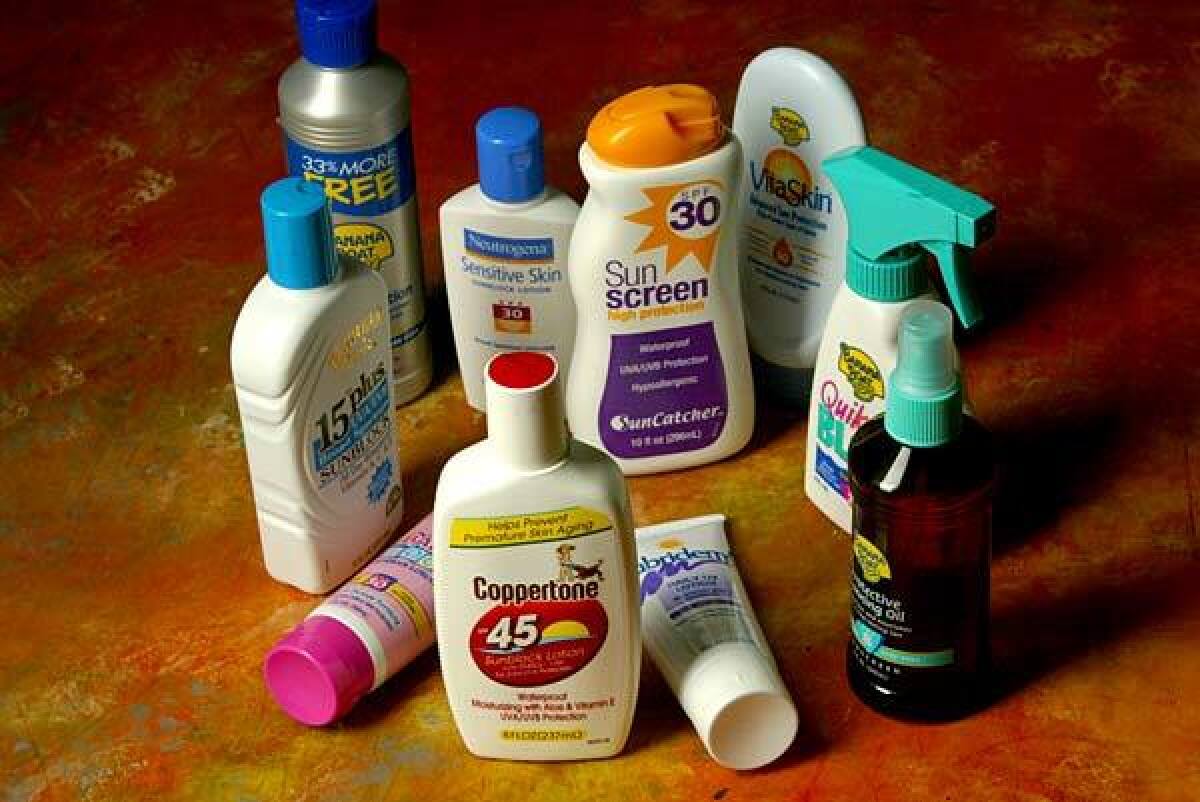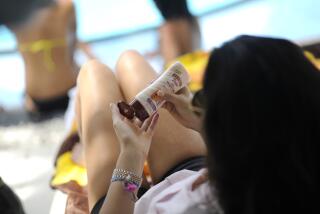Proceed with caution -- and sunscreen

- Share via
With warm weather on the horizon and an ever-proliferating number of sunscreens on the market, Health decided it was time to find out more about protection from the sun. We consulted Dr. Robert Greenberg, a nationally known dermatologist in private practice in Vernon, Conn., who serves on the board of directors of the American Academy of Dermatology and is an assistant clinical professor of dermatology at the University of Connecticut Health Center.
Question: The first thing we’d better emphasize is that sunscreen isn’t just for summer.
Answer: That’s right. If the weather is cool and windy, you’ll stay out longer because you won’t notice the risk, but it’s certainly still there.
*
Q: Is the ever-depleting ozone layer another reason why wearing sunscreen is so imperative?
A: Yes. People also have more leisure time that they spend outdoors. The most important reason why sunscreen use is so important is the dramatic rise in the incidence of skin cancer.
*
Q: Sunscreen manufacturers throw a lot of numbers at us. There are lotions with sun protection factors, or SPFs, of 15, 30 and 45, just to name a few. Please define what this means and what level SPF one needs to be safe.
A: It depends on your skin pigmentation. The way SPF is calculated is based on MED, which stands for minimal erythema dose. Erythema means redness. The MED is the minimal amount of ultraviolet rays that will cause redness 24 hours later, which is the peak reaction time. Someone who is very fair may have an MED of 5-15 minutes at midday. That means they can stay out for five to 15 minutes before their skin will turn red. Someone with a lot of pigment in their skin can maybe stay out for an hour. Now, the SPF number in sunscreen is a multiple. When you use it, it gives you an amount of time that you can stay out in the sun for the same redness the next day. For instance, take a very fair person with an MED of 5. If they use an SPF sunscreen of 15, that means they can stay out in the sun for 75 minutes and get the same reaction. Someone with an MED of 30 who uses a sunscreen with an SPF of 15 can stay in the sun for 450 minutes. That’s more than seven hours.
*
Q: How does altitude, latitude and medication affect that protection?
A: At a standard latitude for an average person, a 15 SPF will give you 93 percentage protection. If you use a 45 or 50 SPF, that will gain you an extra 5 to 10% protection. If you’re very fair, if you’re on medication that makes you photosensitive, or sensitive to the sun’s rays, if you have lupus, a disorder that’s notably photosensitive, you may actually need the higher number SPF. For someone who’s particularly sensitive, 30 usually is fine. You may want 45 if you’re on photosensitive drugs. And if you’re closer to the equator or higher in altitude where ultraviolet rays are more intense, a SPF of 15 isn’t going to give you that protection. You’d need to go higher.
*
Q: But then why wouldn’t I want to use a 50 SPF all the time, just to be safe and receive incrementally more protection?
A: There’s no terrible disadvantage to using higher numbers, but you shouldn’t be misled that it’s going to give you extra protection if you don’t use it as intended. Sunscreens are meant to be applied every two to three hours of exposure time. It’s not like if you use a 30 first thing in the morning, you’ll be protected through the day and it’s going to work better than a 15. Both have to be applied every two to three hours. Usually, an ounce will cover the average-sized person.
*
Q: What about reapplying after being in the water? Some sunscreens claim to be waterproof or water-resistant, but are they really?
A: Despite the sunscreen label, it’s wise to reapply sunscreens after swimming and sweating.
*
Q: There are many active ingredients in a tube of sun block. Which are better? Is there one or a combination that offers more protection?
A: There are two general classes of sunscreening agents. The chemical sunscreen and the physical sunscreens called sun blocks. Chemical sunscreens absorb UV radiation and convert it to heat or fluorescence. Physical sunscreens mainly block and reflect the sun’s rays. These include titanium dioxide and zinc oxide--that’s the white stuff that the lifeguards put on their noses. There are also sun blocks now that have microfine particles in them; they have a slightly whitish tint, but they’re not white and are more cosmetically acceptable to use.
*
Q: Do they both work equally well? And which active ingredients are necessary or best for protection? Or are they all the same?
A: Chemical sunscreens fall into many categories. There are the paba derivatives. The one most people know is padimate O. Other categories include the salicylates (homosalate and octyl salicylate), the benzophenones (oxybenzone, sulisobenzone and dioxybenzone), the cinnamates (cinoxate, octyl methoxycinnamate), the dibenzoylmethanes (avobenzone, also called parsol 1789), and the anthranilates (menthyl anthanilate). Since these products are effective for various UV wavelengths, manufacturers often use a combination of these agents in their sunscreen products.
*
Q: But is one better than another?
A: There really isn’t just one or two particular ingredients that people should look for. Each of the chemical sunscreen ingredients block specific portions of the UV spectrum and differ from one another in their capacity to do so. One can’t really say which is “better”; they’re just different.
*
Q: Why do most sunscreens seem to be so greasy? How can consumers buy one that doesn’t leave their skin [feeling] like an oil slick?
A: Manufacturers often add emollients and moisturizers to sunscreens to lubricate and moisturize the skin. Consumers may want to try [sun block] lotions or gels if they find a particular product too greasy.
*
For information, contact the American Academy of Dermatology at https://www.aad.org or the Skin Cancer Foundation at https://www.skincancer.org.






